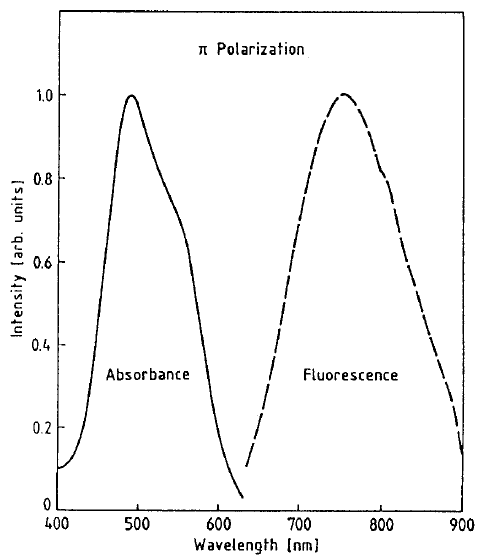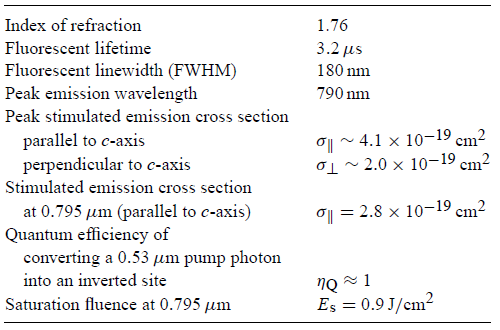


 الفيزياء الكلاسيكية
الفيزياء الكلاسيكية
 الكهربائية والمغناطيسية
الكهربائية والمغناطيسية
 علم البصريات
علم البصريات
 الفيزياء الحديثة
الفيزياء الحديثة
 النظرية النسبية
النظرية النسبية
 الفيزياء النووية
الفيزياء النووية
 فيزياء الحالة الصلبة
فيزياء الحالة الصلبة
 الليزر
الليزر
 علم الفلك
علم الفلك
 المجموعة الشمسية
المجموعة الشمسية
 الطاقة البديلة
الطاقة البديلة
 الفيزياء والعلوم الأخرى
الفيزياء والعلوم الأخرى
 مواضيع عامة في الفيزياء
مواضيع عامة في الفيزياء|
Read More
Date: 27-3-2016
Date: 29-1-2021
Date: 28-1-2021
|
Ti : Sapphire
Since laser action was first reported, the Ti : Al2O3 laser has been the subject of extensive investigations and today it is the most widely used tunable solid-state laser. The Ti : sapphire laser combines a broad tuning range of about 400 nm with a relatively large gain cross section that is half of Nd :YAG at the peak of its tuning range. The energy level structure of the Ti3+ ion is unique among transition-metal laser ions in that there are no d state energy levels above the upper laser level.
The simple energy-level structure (3d1 configuration) eliminates the possibility of excited-state absorption of the laser radiation, an effect which has limited the tuning range and reduced the efficiency of other transition-metal-doped lasers.
In this material, a Ti3+ ion is substituted for an Al3+ ion in Al2O3. Laser crystals, grown by the Czochralski method, consist of sapphire doped with 0.1% Ti3+

FIGURE 1. Absorption and fluorescence spectra of the Ti3+ ion in Al2O3 (sapphire).
TABLE 1. Laser parameters of Ti : Al2O3.

by weight. Crystals of Ti : Al2O3 exhibit a broad absorption band, located in the blue–green region of the visible spectrum with a peak around 490 nm. The great interest in this material arises from the broad vibronic fluorescence band that allows tunable laser output between 670–1070 nm, with the peak of the gain curve around 800 nm.
The absorption and fluorescence spectra for Ti : Al2O3 are shown in Fig.1. The broad, widely separated absorption and fluorescence bands are caused by the strong coupling between the ion and host lattice and are the key to broadly tunable laser operation. The laser parameters of Ti : Al2O3 are listed in Table 1.
Besides having favorable spectroscopic and lasing properties, one other advantage of Ti : Al2O3 is the material properties of the sapphire host itself, namely very high thermal conductivity, exceptional chemical inertness, and mechanical rigidity. Ti : sapphire lasers have been pumped with a number of sources such as argon and copper vapor lasers, frequency doubled Nd :YAG and Nd : YLF lasers, as well as flashlamps. Flashlamp pumping is very difficult to achieve in Ti : sapphire because a very high pump flux is required. The reason for that is the short fluorescence lifetime of 3.2μm, which results in a small product of stimulated emission cross section times fluorescence lifetime (στ f ). The population inversion in a laser required to achieve threshold is inversely proportional to στ f.
Commercial Ti : sapphire lasers are pumped by argon lasers or frequencydoubled Nd :YAG or Nd : YLF lasers. Figure 2 displays the output of a Ti : sapphire laser pumped at 1 kHz by a frequency-doubled Nd : YLF laser which had an average output of 1.7W at 527 nm. A very important application of Ti : sapphire lasers is the generation and amplification of femtosecond mode-locked pulses. Kerr lens mode-locking and chirped pulse amplification with Ti : sapphire lasers.

FIGURE 2. Tuning range of a Ti : sapphire laser pumped by a Nd :YLF laser at 1 kHz.



|
|
|
|
"عادة ليلية" قد تكون المفتاح للوقاية من الخرف
|
|
|
|
|
|
|
ممتص الصدمات: طريقة عمله وأهميته وأبرز علامات تلفه
|
|
|
|
|
|
|
المجمع العلمي للقرآن الكريم يقيم جلسة حوارية لطلبة جامعة الكوفة
|
|
|